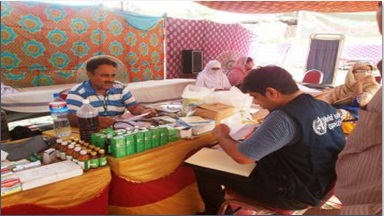 WHO’s Surveillance Officer collecting disease data from the field hospitalStagnant water in the flood affected areas may cause severe health issues along with dengue and other waterborne diseases, 74 health facilities affected
WHO’s Surveillance Officer collecting disease data from the field hospitalStagnant water in the flood affected areas may cause severe health issues along with dengue and other waterborne diseases, 74 health facilities affected
by flood, 326 mobile medical teams and 367 medical camps are operational, LLITNs are needed for prevention of malaria especially among pregnant women and under 5 children in flood-affected districts.
Vitamin A supplementation will be part of NID starting from 29 September 2014, partners are on the ground, working closely with local authorities to support the affected populations with much needed food, non-food items, health services including medicines, emergency health kits, and monitoring the situation for waterborne diseases.
Despite challenges in terms of physical access to where the affected communities are located, due to floodwater and damaged roads, partners continue to work among the affected populations.
According to NDMA, an estimated 346 people are reported to have lost their lives and 620 people have been injured due to the flash floods. The number of fatalities is likely to increase as communication lines are re-established. According to NDMA more than 55 200 houses have been reported as damaged or destroyed while nearly 2.4 million acres of crop area has been affected by the floods. To provide immediate assistance to the affected families, 459 relief camps have been set up in the affected areas, providing emergency health care, cooked food, some non-food items and temporary shelter. The authorities expect an estimated total 3 million people to be affected by the floods in the coming days.
The National Disaster Management Authority (NDMA) requested the humanitarian community to roll out the Multisector Initial Rapid Assessment (MIRA) in five of the worst affected districts in Punjab Jhang, Mandi Bahauddin, Multan, Chiniot and Hafizabad. The MIRA data are now available and under process for analysis and assessment report, to date, no formal request for international assistance from the federal Government has been received.
Currently, the worst affected areas are in Punjab, Gilgit Baltistan, and Kashmir and Jammu. In northern and central Punjab, the water has been seen to recede. Physical access is a challenge as many roads are destroyed, and water covers access routes.
The heavy spell of monsoon rains have resulted in exceptionally high levels of water in rivers Indus, Chenab and Jhelum causing flash floods in different areas of the country affecting Sialkot, Narowal, Lahore, Gujranwala, Mandi Bahauddin, Gujrat, Hafizabad, Jhelum, Chiniot, Sargodha and Okara in Punjab; Hattian Bala, Haveli and Sudhnoti in Azad Jammu and Kashmir; and Diamir in
WHO's response
WHO suboffice in Punjab has been in continuous coordination with the Department of Health from the beginning of the contingency planning phase for the monsoon season. Below is a brief summary of WHO actions.
- Establishment of daily reporting system involving DEWS from all affected districts, data collection, analysis and sharing.
- Regular visits of WHO field teams (polio and DEWS) to the affected camps in all districts and report sharing regularly.
- A rapid situation assessment exercise was conducted with the support of polio eradication teams in all affected districts.
- Assessment of Intensified EPI campaign in affected districts by the polio team
- Sectoral coordination meeting started at provincial level attended by representatives of UN agencies, nongovernmental organizations, international nongovernmental organizations and Department of Health.
- Coordination mechanism with national health emergency preparedness and response network (NHEPRN), NDMA, UNICEF and UNFPA and NGO partners is in place at federal level in Islamabad.
Public health concerns
- High risk of waterborne diseases due to stagnant and contaminated water in the affected areas.
- Increase in acute respirtaory infections, diarrhoea, and skin diseases in affected population
- Damage to roads and infrastructures thus compromising access to information and health services.
- Shortage of essentially required medicines due to substantial magnitude of problem
- Accidents and injuries
- Shortage of anti-snake venom and anti-rabies vaccines
- Interruption in routine vaccination activities.
Related links
Health situation report, no 2, Flood emergency [pdf 543Kb]
Health situation report, no 1, Flood emergency [pdf 682Kb]
Satellite Image Analysis of Flooding in Sialkot District, Punjab Province as of (9-9-2011) [pdf 847]



